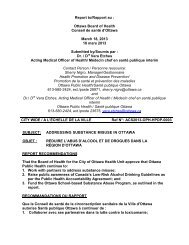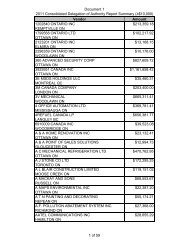Mer Bleue - Planning Framework - City of Ottawa
Mer Bleue - Planning Framework - City of Ottawa
Mer Bleue - Planning Framework - City of Ottawa
Create successful ePaper yourself
Turn your PDF publications into a flip-book with our unique Google optimized e-Paper software.
3.0 <strong>Planning</strong> <strong>Framework</strong><br />
A full review <strong>of</strong> existing conditions was prepared as part <strong>of</strong> the Plan process and available under separate<br />
cover. The Final version <strong>of</strong> the Existing Conditions Report is dated January 18, 2006 and should be<br />
consulted for complete information. The following section provides a summary <strong>of</strong> the information<br />
contained in the Existing Conditions Report.<br />
3.1 General Characteristics<br />
The CDP area is part <strong>of</strong> the Orléans Expansion Area. The uses surrounding the CDP Area include<br />
residential and rural uses to the south, vacant lands to the west, developing employment and commercial<br />
lands north <strong>of</strong> the hydro corridor (a Hydro One easement for 115KV and 230 KV lines) and a mix <strong>of</strong><br />
commercial development and vacant lands designated and being developed for residential development,<br />
on the east side <strong>of</strong> Tenth Line Road. A municipal snow disposal facility is planned west <strong>of</strong> the CDP Area<br />
along <strong>Mer</strong> <strong>Bleue</strong> Road, north <strong>of</strong> the hydro corridor. The CDP area has some structures, mainly farming<br />
related and a few homes, with much <strong>of</strong> the land being largely vacant and undeveloped.<br />
Intersection <strong>of</strong> <strong>Mer</strong> <strong>Bleue</strong> Road and Renaud Raod<br />
<strong>Mer</strong> <strong>Bleue</strong> Road looking north
The Hydro Corridor is the northern boundary<br />
<strong>of</strong> the CDP Study area<br />
Intersection <strong>of</strong> Innes Road and <strong>Mer</strong> <strong>Bleue</strong> Road<br />
Tenth Line Road looking south
Minto’s Avalon Community, east side <strong>of</strong> Tenth Line Road<br />
McKinnon’s Creek at<br />
<strong>Mer</strong> <strong>Bleue</strong> Road
New commercial development along Innes Road<br />
Unoccupied dwelling along Tenth Line Road<br />
CDP Study Area looking west from Tenth Line Road
3.2 Schools, Parks & Open Space<br />
There is a total <strong>of</strong> 31 schools located within the influence <strong>of</strong> the CDP area, each belonging to one <strong>of</strong> the<br />
four following area boards: <strong>Ottawa</strong>-Carleton District School Board; Conseil des écoles publiques de l’Est<br />
de l’Ontario; <strong>Ottawa</strong>-Carleton Catholic School Board; and Conseil des écoles catholiques de langue<br />
française. Of the 31 schools, 6 are high schools and 25 are elementary schools.<br />
Initial investigation with all four school boards has revealed the potential need for 2 new schools as part <strong>of</strong><br />
the development <strong>of</strong> the <strong>Mer</strong> <strong>Bleue</strong> area. The <strong>Ottawa</strong>-Carleton Catholic School Board (OCCSB) has<br />
expressed the need for 8.1 ha site to accommodate a new intermediate/high school within the Study<br />
Area. The <strong>Ottawa</strong>-Carleton District School Board (OCDSB) has requested 2.8 ha for a future elementary<br />
school.<br />
There are no city parks or recreation facilities within the CDP area, however there are some significant<br />
natural features (<strong>Mer</strong> <strong>Bleue</strong> Bog) and major recreation facilities within the influence <strong>of</strong> the CDP area as<br />
indicated in Figure 5. In addition, nearby existing residential communities have a number <strong>of</strong><br />
neighbourhood, community and district parks generated through park dedications at the time <strong>of</strong><br />
subdivision approval.<br />
Figure 5- Parks and Open Space
3.3 Transportation<br />
Road Network<br />
<strong>Mer</strong> <strong>Bleue</strong> Road is a two-lane urban arterial with rural cross-section and a posted speed limit adjacent to<br />
the site <strong>of</strong> 60 km/h. The road is under the jurisdiction <strong>of</strong> the <strong>City</strong> <strong>of</strong> <strong>Ottawa</strong>. Tenth Line Road is a twolane<br />
arterial road with a rural cross-section and a posted speed limit <strong>of</strong> 80 km/h adjacent to the CDP<br />
Area.<br />
Innes Road is an arterial road located to the north <strong>of</strong> the CDP Area. The recently widened four-lane<br />
arterial provides an east-west connection between <strong>Mer</strong> <strong>Bleue</strong> Road and Tenth Line Road. Although<br />
Innes Road currently has a posted speed limit <strong>of</strong> 80 km/h at this location, it is expected that the limit will<br />
be lowered once the road widening is completed. The road is under the jurisdiction <strong>of</strong> the <strong>City</strong> <strong>of</strong> <strong>Ottawa</strong>.<br />
Transit Network<br />
There are no bus routes currently operating on <strong>Mer</strong> <strong>Bleue</strong> Road south <strong>of</strong> Innes Road. Express route 32<br />
operates on Tenth Line Road, south <strong>of</strong> Innes Road to service the Avalon community. Transit service is<br />
provided on Innes Road north <strong>of</strong> the site by regular bus routes 131 and 137. As well, express routes 33<br />
and 21 provide peak hour service on Innes Road east and west <strong>of</strong> <strong>Mer</strong> <strong>Bleue</strong> Road and onto Jeanne<br />
D’Arc Boulevard. However, starting September 2006, a new Route 94 will be implemented, which will<br />
provide direct-to-downtown service along Innes Road. Service will no longer be provided on Innes Road<br />
on Routes 21 and 33.<br />
Route 94 will be a prelude to service, which will operate in the future Rapid Transit corridor. Early<br />
morning service route 835 is provided on Innes Road between Prestwick Drive and Tenth Line Road.
Figure 6 – Transportation Network<br />
Screenline Volumes<br />
The <strong>City</strong> <strong>of</strong> <strong>Ottawa</strong> has identified major transportation screenlines for the purpose <strong>of</strong> monitoring and<br />
determining future transportation needs. Of relevance to the proposed development, the Bilberry Creek<br />
Screenline is located on a north-south axis within the proposed development and east <strong>of</strong> <strong>Mer</strong> <strong>Bleue</strong><br />
Road.<br />
Based on the information in the CCL Transportation Overview (2004) and the Delcan report for Eden Park<br />
(2003), the modal split to transit at the Bilberry Creek Screenline is 27% in the morning peak hour and<br />
22% in the afternoon peak hour. This compares favourably to the <strong>City</strong>-wide average <strong>of</strong> 17% in the<br />
afternoon peak hour.<br />
Further west, the Green’s Creek Screenline located west <strong>of</strong> Blackburn Hamlet, captures travel in the eastwest<br />
corridor between the Orleans Community and the rest <strong>of</strong> the <strong>City</strong> <strong>of</strong> <strong>Ottawa</strong>. The dominant influence<br />
on traffic volumes crossing the Green’s Creek Screenline is the scale <strong>of</strong> development in both Blackburn<br />
Hamlet and Orleans. Based on information provided in the 2003 Delcan CDP, the transit modal split at<br />
the Green’s Creek Screenline during the morning peak hour is 31.6% and during the afternoon peak hour<br />
30.6% based on 2002 data.<br />
It has been concluded that the Bilberry Creek and Green’s Creek Screenlines are operating currently at<br />
overall acceptable levels <strong>of</strong> service in both the morning and afternoon peak hours.<br />
As well, the higher than average modal splits at each screenline indicate the high level <strong>of</strong> transit use in<br />
the Orleans Community, which currently exists.
Pedestrian and bicycle modal splits at each screenline are very low. In the case <strong>of</strong> Green’s Creek<br />
Screenline, the bicycle and pedestrian modal splits are 1% with 0% in the morning and afternoon peak<br />
hours respectively. At the Bilberry Creek Screenline, the bicycle percentage is approximately 1% and the<br />
pedestrian percentage is approximately 1% in the morning and afternoon peak hours respectively.<br />
Intersection Capacities<br />
The key intersections adjacent to the CDP Area are Innes Road/<strong>Mer</strong> <strong>Bleue</strong> Road and Innes Road/Tenth<br />
Line Road. It is evident that the key intersections on Innes Road adjacent to the proposed development<br />
site were close to capacity for critical movements under pre-widening conditions. In the case <strong>of</strong> Innes<br />
Road/<strong>Mer</strong> <strong>Bleue</strong> Road, under pre-widening conditions the intersection operated at Level <strong>of</strong> Service D and<br />
E, respectively (2003 volumes). Similarly, Innes Road/ Tenth Line Road operated at Level <strong>of</strong> Service B<br />
and D, respectively. The <strong>City</strong> <strong>of</strong> <strong>Ottawa</strong> is finalizing construction <strong>of</strong> a four-lane Innes Road between<br />
Orleans Boulevard and Tenth Line Road. This will provide increased capacity at the key intersections<br />
identified above, and improvements in the Levels <strong>of</strong> Service for the critical movements indicated.<br />
Cycling & Pedestrian Network<br />
The <strong>City</strong> <strong>of</strong> <strong>Ottawa</strong> Cycling Plan identifies <strong>Mer</strong> <strong>Bleue</strong>, Tenth Line, Blackburn Hamlet Bypass Extension<br />
and Innes Road as on-road cycling routes. In addition, the Plan identifies a future <strong>of</strong>f-road cycling route<br />
within the Hydro Corridor.<br />
3.4 Municipal Servicing<br />
Water Infrastructure<br />
The CDP Area is identified as ‘Neighbourhood 5’ (N5) in previous servicing studies. Water service to the<br />
N5 lands is provided by an existing 406 and 152 mm watermains along Tenth Line Road on the east side.<br />
The water distribution system is capable <strong>of</strong> providing large fire flows and maintaining water pressure to<br />
the CDP Area due to the proximity <strong>of</strong> the Innes Road Water Storage Tank.<br />
The area in the vicinity <strong>of</strong> N5 is currently serviced with water from a 600mm diameter watermain in Innes<br />
Road, which extends from Belcourt Boulevard to Trim Road. This main feedermain supplies several<br />
smaller 406mm diameter feedermains, which extend southerly from Innes Road in Tenth Line Road,<br />
Esprit Drive and Portabello Drive. As development advances, an additional 406mm diameter feedermain<br />
will be added in <strong>Mer</strong> <strong>Bleue</strong> Road and another 610mm diameter feedermain will be installed along the<br />
hydro corridor from Pagé Road to <strong>Mer</strong> <strong>Bleue</strong> Road to complete the main water supply for this portion <strong>of</strong><br />
the EUC in the vicinity <strong>of</strong> NH5.<br />
Wastewater Infrastructure<br />
The wastewater outlet for this development is the future Tenth Line Road Pump Station located in the<br />
southeast corner <strong>of</strong> the CDP area and the proposed gravity sewer, which will be installed in Tenth Line<br />
Road from the Billberry Creek Industrial Park to the proposed pumping station. The pump station will also<br />
service the adjacent Avalon South lands situated east <strong>of</strong> Tenth Line Road. The construction contract for<br />
the Station is nearing completion and expected to be commissioned by summer 2006. Flow from the<br />
pump station is discharged into trunk sewers in Neighbourhood 4 which outlet to the existing 900 mm<br />
sanitary sewer on Esprit Drive. A trunk sanitary sewer flowing south on Tenth Line Road and outletting<br />
into the pump station is presently being designed. Construction is planned for 2006.<br />
Stormwater Management<br />
Stormwater run<strong>of</strong>f from the CDP area flows south through agricultural drains into McKinnons Creek,<br />
which diagonally flows along the southwest corner <strong>of</strong> the site and crosses Tenth Line Road at Wall Road
to the south. A revised Master Drainage Plan (MDP), which followed the Environmental Assessment (EA)<br />
process, was completed in 2000. The MDP calls for a storm water management pond to treat post<br />
development run<strong>of</strong>f from the CDP Area (Neighbourhood 5), which will outlet to McKinnons Creek. It also<br />
proposes a separate storm water pond to treat post development flows from Neighbourhood 4 (to the<br />
east), which will also outlet to McKinnons Creek just south <strong>of</strong> Wall Road via a storm sewer along the<br />
Tenth Line Road right-<strong>of</strong>-way.<br />
Figure 7 – Stormwater Management<br />
3.5 Soil Conditions<br />
A Phase 1 Environmental Site Assessment was prepared by Paterson Group in November 2005 in order<br />
to research the past use <strong>of</strong> the site and identify actual or potential contamination. The assessment<br />
concluded that the historical data researched for this site did not indicate any areas <strong>of</strong> concern regarding<br />
the past uses <strong>of</strong> the site and adjacent properties.<br />
Paterson Group also prepared a Preliminary Geotechnical Investigation (January 18, 2006) for the CDP<br />
Area. The geotechnical investigation revealed that the soil pr<strong>of</strong>ile in the area consists <strong>of</strong> a layer <strong>of</strong> topsoil<br />
overlying a layer <strong>of</strong> silty clay varying in thickness from 20 to 26m at the east end <strong>of</strong> the CDP Area and<br />
from 9 to 19m at the west end. Topsoil was encountered at ground surface at all test hole locations.<br />
Below the silty clay is the limestone and shale bedrock. Key findings contained in the report are as<br />
follows:<br />
Geotechnical Assessment<br />
For the most part, the subsoil conditions at this site consist <strong>of</strong> a deep firm to stiff silty clay deposit. From a<br />
geotechnical perspective, the subject land will be subjected to grade raise restrictions if routine shallow<br />
footing foundations are used.
If higher-grade raises are required, pile foundations, preloading with or without a surcharge, light weight<br />
fill and/or other measures should be investigated to reduce the risks <strong>of</strong> unacceptable long-term post<br />
construction total and differential settlements.<br />
3.6 Natural Heritage<br />
The following section is a summary <strong>of</strong> the findings and conclusions <strong>of</strong> fieldwork and research conducted<br />
by Niblett Environmental Associates in the fall <strong>of</strong> 2005. Detailed findings and observations are contained<br />
in the <strong>Mer</strong> <strong>Bleue</strong> Community Design Plan, Existing Conditions Report, dated January 18, 2006.<br />
3.6.1 Features and Functions<br />
No significant natural heritage designations are present in the CDP Area. This includes provincially<br />
significant wetlands, Areas <strong>of</strong> Natural and Scientific Interest and significant wildlife habitat. The recent<br />
Urban Natural Areas study conducted by the <strong>City</strong> <strong>of</strong> <strong>Ottawa</strong> (2005) did not identify any woodlands or<br />
other features on or adjacent to the CDP Area.<br />
3.6.2 Significant Species and Habitats<br />
Fisheries<br />
A young <strong>of</strong> the year muskellunge was sampled at Station 4 and young <strong>of</strong> the year northern pike have<br />
been sampled at station 9 in the past. An additional 4 species were sampled at Station 4 with young <strong>of</strong><br />
the year present for all the species. This site is providing nursery habitat and likely nearby spawning<br />
habitat. The presence <strong>of</strong> young <strong>of</strong> the year muskellunge and white sucker indicate that there are likely no<br />
migratory barriers between the site and larger habitat downstream required by the adults.<br />
It is important to maintain this connectivity to continue to provide fish with access to habitats required to<br />
fulfill various lifestages. This area is however downstream <strong>of</strong> the CDP Area. Therefore, work within the<br />
CDP area needs to maintain water quality and quantity objectives so as not to harmfully alter fish habitat<br />
downstream. Fish were also sampled within the CDP area and therefore Authorization would be required<br />
for any work that would result in the harmful alteration, disruption or destruction <strong>of</strong> fish habitat.<br />
The fisheries sampling results show some general seasonal trends. Spring sampling resulted in generally<br />
lower catch-per-unit-effort (CPUE) and numbers <strong>of</strong> species.<br />
Fish likely are moving upstream at this time and their patchy distributions result in lower numbers <strong>of</strong><br />
species.<br />
The progeny from the year’s spawning are in abundance in summer, resulting in higher CPUE and<br />
numbers <strong>of</strong> species. In fall, all fishes are likely seeking deeper downstream refugia habitat for overwintering.<br />
This results in lower CPUE and numbers <strong>of</strong> species versus more upstream areas. Very high<br />
numbers <strong>of</strong> fish were captured in fall at Site 6 indicating the presence <strong>of</strong> possible over-wintering habitat.<br />
Given these findings and the anticipated development for the area, Harmful Alteration, Disruption, or<br />
Destruction (HADD) <strong>of</strong> fish habitat is likely to result. Therefore, appropriate mitigation and compensation<br />
measures will have to be negotiated and approved by the South Nation Conservation Authority SNCA<br />
and the Department <strong>of</strong> Fisheries and Oceans (DFO).
Figure 8 – Fisheries Sampling Locations<br />
Vegetation<br />
A review <strong>of</strong> the plant list for the CDP Area found that none <strong>of</strong> the species are considered nationally or<br />
provincially rare. No significant vegetation communities (Bakowsky, 1997) are present in the CDP area.<br />
A review <strong>of</strong> the Natural Heritage Information Centre (NHIC) list <strong>of</strong> rare species showed record <strong>of</strong> several<br />
rare species in the vicinity <strong>of</strong> the CDP Area, though none were recorded on it. Rare plants listed within 5<br />
km <strong>of</strong> the <strong>Mer</strong> <strong>Bleue</strong> property included; hidden-fruited bladderwort (Utricularia geminiscapa), branching<br />
burreed (Sparganium androcladum), giant pinedrops (Pterospora andromedea), long-stemmed waterwort<br />
(Elatine triandra), cloud sedge (Carex haydenii), long sedge (Carex folliculata),<br />
New England sedge (Carex novae-angliae) and cattail sedge (Carex typhina). Of these species, only the<br />
records for cloud sedge, hidden-fruited bladderwort, long sedge and New England sedge were within 120<br />
m <strong>of</strong> the site.<br />
Hidden-fruited bladderwort and long-stemmed water-wort are floating aquatic species. With no open<br />
water on the site they would not find suitable habitat on this property.<br />
Branching burreed, while not strictly aquatic, does require true wetland habitat and would not survive the<br />
drier periods that regularly occur on this site. Giant pinedrops are saprophytic (living on) pines and thus<br />
grow only where pines grow, precluding them from inhabiting this site.
Cloud sedge, long sedge, New England sedge and cattail sedge are found in moist to wet forest and<br />
bottomland forest. There is no suitable habitat for these species on the property.<br />
Figure 9 – Vegetation Communities<br />
Birds<br />
A review <strong>of</strong> the list <strong>of</strong> bird species recorded for the CDP area (see Appendix) found that none are<br />
considered nationally, provincially and regionally rare.<br />
The CDP area includes one Ontario Breeding Bird atlas square (18VR63) (Bird Studies Canada, 2005).<br />
The database for that square includes results from the 1st atlas (1981-1985) and the current or second<br />
atlas (2001-2005). A list <strong>of</strong> significant species was generated for this square.<br />
Species included ruddy duck (Erismatura jamaicensis rubida), red-shouldered hawk (Buteo lineatus),<br />
black tern (Chlidonias nigra), short-eared owl (Asio flammeus) and loggerhead shrike (Lanius<br />
ludovicianus). All <strong>of</strong> these species are considered Special Concern under COSSARO for Ontario except<br />
the loggerhead shrike, which is listed as endangered on a national and provincial level, and the ruddy<br />
duck, which is listed on the Ontario Birds at Risk database only (2005).<br />
The black tern prefers wetlands with cattails and large open water areas associated with lakes or rivers<br />
and nesting sites that include stumps, muskrat pushups and muddy banks. No suitable habitat is present<br />
on or adjacent to the property.
Ruddy duck is found in small lakes and sewage lagoons. There is no suitable habitat for this species in<br />
the CDP area.<br />
Red-shouldered hawk prefers large contiguous woodlands <strong>of</strong> 100 ha or greater with mature deciduous or<br />
mixed forest or swamp. This species would not find suitable habitat on or near the subject property.<br />
The short-eared owl prefers open grasslands, marshes and bogs. The species is found in the <strong>Ottawa</strong><br />
area where extensive grassland and abandoned fields are present.<br />
This species has experienced declines in population throughout its range and has also declined in the<br />
<strong>Ottawa</strong> area in recent years. Short-eared owls have large territories (>100 ha) and are considered an<br />
area sensitive species. This species may find suitable habitat in the abandoned fields on the southern<br />
portion <strong>of</strong> the CDP area.<br />
The loggerhead shrike is found in open hawthorn and red cedar pastures, neither <strong>of</strong> which habitat is<br />
present on the subject property. It is endangered in Canada and Ontario and has a very restricted range<br />
that currently does not include this area. Since the first atlas its population has declined to where it is no<br />
longer found in Eastern Ontario or the <strong>Ottawa</strong> area.<br />
A review <strong>of</strong> the NHIC database found no recent records <strong>of</strong> nationally or provincially significant bird<br />
species.<br />
Mammals<br />
A review <strong>of</strong> the list <strong>of</strong> mammals observed and reported for the CDP area found that none are considered<br />
significant on a national, provincial or regional level. Both coyote and white-tailed deer are typical for rural<br />
areas in the <strong>Ottawa</strong> area.<br />
Natural Heritage Information Centre (NHIC)<br />
The NHIC lists numerous records for “sensitive species” within 5 km and several within 120 m <strong>of</strong> the<br />
subject property, although none are found on the property. Sensitive species are not identified in the<br />
database and as such cannot be commented upon. All <strong>of</strong> the records are from the 1940-1994 period.<br />
3.7 Key Influences<br />
Based on the review <strong>of</strong> existing conditions affecting the future development <strong>of</strong> the <strong>Mer</strong> <strong>Bleue</strong> area, a few<br />
key considerations are <strong>of</strong> note. They are as follows and further details in Section 4.2 (Concept Plan<br />
Assumptions).<br />
• Soil Conditions<br />
• McKinnon’s Creek<br />
• Community Integration and Linkages<br />
• Employment<br />
• Snow Disposal Facility<br />
• Servicing<br />
• Rapid Transit Corridor<br />
• Blackburn Hamlet Bypass Extension
Figure 10 – Key Influences









